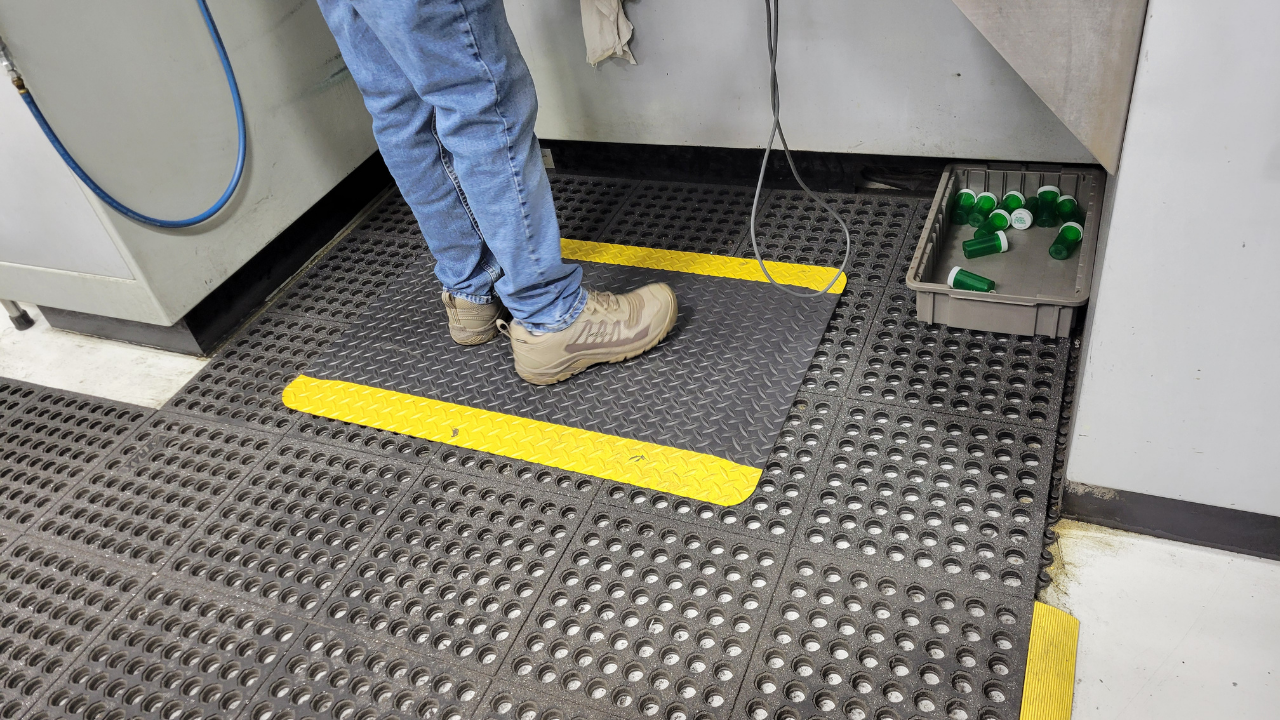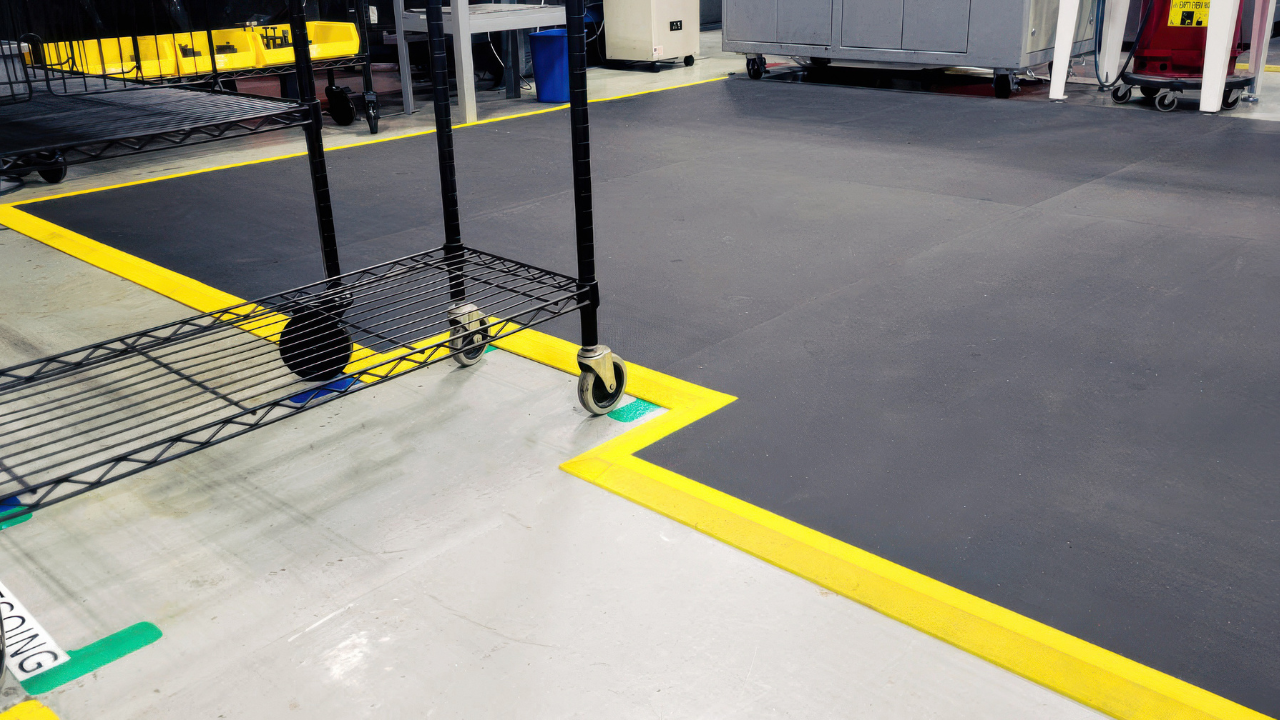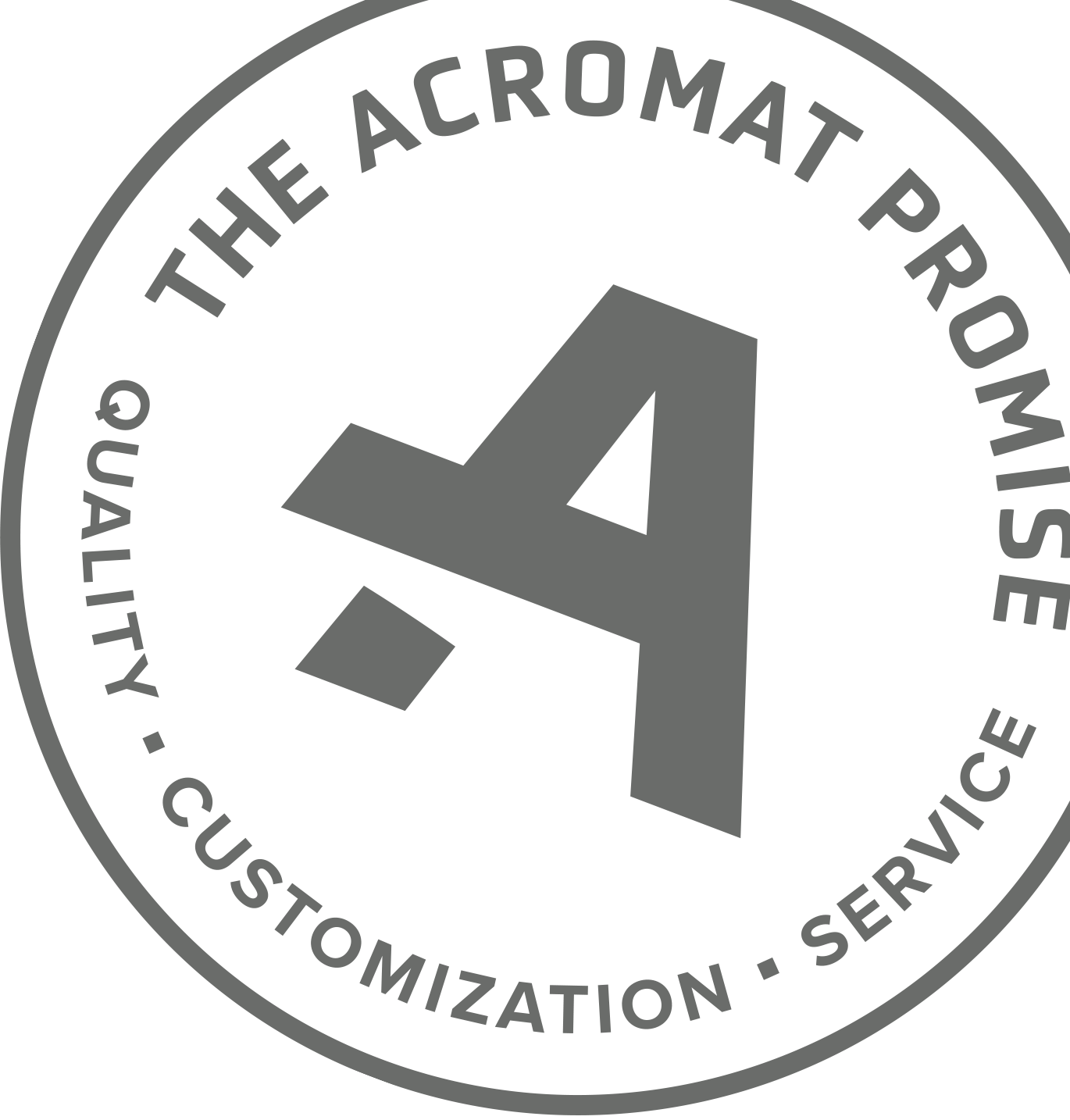Occupational Health & Safety (OH&S) Magazine put together 9 essential questions you should always ask before buying anti-fatigue mats. According to OH&S, “The questions are based on a broad analysis of research data relating to the effectiveness of standing and working surfaces and their impact on reducing fatigue, preventing injury, and increasing productivity.”
Multiple AcroMat clients have used this OH&S resource to determine if our mats are the right fit. Here are our answers to each of the 9 questions – sharing how AcroMat anti-fatigue mats meet OH&S best practices for ergonomic standing surfaces.
1. Has the mat been optimized for softness and hardness?
 For the purpose of this study, we are looking at the AcroMat 100-1 Series, 100-ESD Series, and the 100-Cleanroom Series anti-fatigue mats.
For the purpose of this study, we are looking at the AcroMat 100-1 Series, 100-ESD Series, and the 100-Cleanroom Series anti-fatigue mats.
Made from closed cell, molded, 100% nitrile rubber, the AcroMat 100-Series anti-fatigue mats have a medium-soft Shore C durometer rating, which fall within the 70-100 Shore 00, Shore 0, and Shore A durometer scales.
Over 15 years of testing and partnering with ergonomists, occupational therapists and injury prevention specialists, and client feedback, we’ve found this to be the ideal cushion for workers who stand for 8-10 hours each shift. This level of cushion provides critical support without being too soft and causing added ankle pressure or instability.
Crystal Nelson, Occupational Therapist, Ergonomist, and the Owner of ergonomic consultancy, Alter Ergo, joined an AcroMat webinar to discuss how anti-fatigue mats work along with critical tips for getting the right mats. Clipped from this webinar, in the short video below, our General Manager Russell Herbert and Crystal Nelson discuss what happens when mats are too soft:
2. Does the mat provide balance between instability & stability?
The AcroMat 100-Series anti-fatigue mats are made to a precise 5/8 in. thickness. Studies show anti-fatigue mats that are 5/8 in. to 3/4 in. thick mat have the lowest rating for overall tiredness – which is 50% lower than hard surfaces.
This thickness allows fast-moving employees to navigate on and around their anti-fatigue mats, and experience the ergonomic benefit, without tripping or sinking into the material.
As highlighted in the video above, anti-fatigue mats that are 1 in. thick or more put added pressure on a worker's ankles. This can also increase the risk of rolled ankles. Mats that are less than 3/8 in. thick lack support and provide the same amount of cushion as hardwood.
Miller Supervisor Barry Setzer with Titans of CNC and two of his teammates share how the comfort of their AcroMat mats have relieved pain they experienced for decades prior.
3. Does the mat resist bottoming out without being too soft?
AcroMat subjected its 100-Series anti-fatigue mats to ASTM D3574-17, Test I3 – Dynamic Fatigue Test by Constant Force Pounding, the internationally recognized, standardized testing process to determine anti-fatigue mat resilience and resistance to bottoming out.
After 80,000 170-lbs. compressions over the course of 24 hours, the AcroMat 100-Series nitrile rubber material not only didn't soften but maintained over 98% of its thickness. The material also continues to regain its form and shape over time. Conversely, two leading competitor mats lost 4.4-6.1% of their thickness and continued to lose additional form and shape after 24 hours.
In summary, according to the ASTM D3574-17 testing, AcroMat anti-fatigue mats are 2.3-3.2X more resilient than leading competitor anti-fatigue mats.

2% or less loss indicates permanent resistance to deformation, while greater than 2% indicates likely continued break down. The AcroMat 100-Series mats are the only mats to lose less than 2% of its thickness after 80,000 170-lbs. compressions over 24 hours.
Dig Deeper: AcroMat Outperforms Competitor Mats By 3X In ASTM Fatigue Testing
4. Does the mat adequately respond to worker movements?
As the OH&S article states, "A surface that is slow to respond is prone to bottoming out. If the return is actually in phase with the movement, less energy may be used as the mat helps with movement, much like a spring. Adequate responsiveness works in concert with optimal bottoming-out depth, optimal balance of stability and instability, and optimal compressibility."
Anti-fatigue mat elasticity, or responsiveness, is defined as how a mat absorbs impact and returns energy to the foot, or how quickly it returns to its original shape as weight is shifted. The AcroMat 100-Series mats immediately return energy to the foot, and will do so throughout their useful life. The material will never sink, flatten or compress.
This 2-minute video shows the elasticity of the 100-Series compared to PVC foam mats. Notice how the 100-Series immediately bounces back from multiple types of use, while compressions in the PVC foam mat remains.
5. Does the mat balance shock attenuation & resilience?
We sent a 100-Series mat to Darcie Jaremey, a Board-Certified Professional Ergonomist and the Owner of ergonomicsHelp, for an objective review so we could better understand our overall level of cushioning and resilience.
Here’s a snippet from the review (full review):
What sets AcroMat apart is that it is quite robust to stand on; it holds its shape very well. This means that after standing in one location for a while the mat doesn’t flatten or require you to relocate your feet to get cushion and relief.
Good For Long-Term Standing: This is where quality anti-fatigue mats shine when compared to cheaper models or even using something else that is soft to stand on, like those bright-tiled mats you would frequently see in a toddler’s play area. In my experience, it may seem like you are saving money by buying a cheaper mat, but in the long-run cheaper mats affect the standing experience.
Good Balance: A good anti-fatigue mat will have a good balance between enough cushion and instability, and such is true with this mat. Remember, there needs to be enough cushion to be comfortable for our joints yet have enough of an unstable surface to activate the venous pump (required to improve lower leg circulation). Mats with too little instability will likely not activate the venous pump. On the other hand, mats with too much instability would likely be extremely fatiguing to stand which could affect concentration at work.

100-Cleanroom Series. Shares Darcie, "What sets AcroMat apart is that it is quite robust to stand on; it holds its shape very well. This means that after standing in one location for a while the mat doesn’t flatten or require you to relocate your feet to get cushion and relief."
6. Does the mat get softer as it is compressed?
Most 'box-store' foam mats are extruded using PVC foam or a PVC/nitrile blend. The key difference with AcroMat, our 100-Series mats are molded from closed cell, 100% nitrile rubber. There is no component of PVC foam.
This translates to a higher quality, durability, complete imperviousness to liquids and chemicals, and our guarantee the 100-Series anti-fatigue mats will never sink, flatten or lose their shape (i.e., bottom out).
Molding vs. Extruding
Extruding rubber is the easiest and cheapest way to make foam mats, and why so many providers sell extruded mats. To extrude rubber, you have to add a percentage of PVC foam; PVC is not impervious to liquids or chemicals; the materials will get softer and begin to bottom out over time.
At AcroMat, we manufacture our mats from molded, closed cell, 100% nitrile rubber foam. There is no PVC foam component, which multiplies the durability and versatility. The 100-Series mats will age over time, as all mats do, but as long as they are in use the ergonomic cushion will remain uninterrupted.
 The graph above shows the average lifespan of PVC foam, PVC/nitrile blended foams, and 100% nitrile. While mats do age from heavy use, as long as the pure nitrile 100-Series mats are in use, their cushion will not be interrupted.
The graph above shows the average lifespan of PVC foam, PVC/nitrile blended foams, and 100% nitrile. While mats do age from heavy use, as long as the pure nitrile 100-Series mats are in use, their cushion will not be interrupted.
The cushion you feel when first standing on the mat, which has been precisely designed to provide balance between comfort and stability for long-term standing, will remain permanently intact whether 10 months or 10 years down the road. We guarantee this as part of our Lifetime Performance Warranty.

Under the AcroMat Lifetime Performance Warranty, we guarantee our 100-Series mats will remain permanently resilient and never sink, flatten or lose their ergonomic cushion. We also guarantee they will never curl along the borders, eliminating a dangerous trip hazard.
7. Does the mat resist movement under use?
The AcroMat 100-Series anti-fatigue mats are textured to prevent sliding, made from a material (nitrile rubber) that resists sliding, certified for high traction, and can be customized to fit like a glove. If you need extra support on especially slick-smooth floors, we also manufacture a proprietary non-slip coating called Grip-R.
NFSI Certification
The AcroMat 100-Series mats are National Floor Safety Institute "High Traction" Certified. NFSI is an independent testing agency that uses an intricate testing system to identify how mats keep users safe from slips and falls. This testing helps you know with certainty you're investing in mats that will retain traction even when wet and prevent sliding.
The 100-Series was tested according to NFSI's Transitional Coefficient of Friction (TCOF) scale, earning a score of 0.76 – the very top end of NFSI's "high traction" category. According to NFSI, floor surfaces with a 0.6 TCOF or greater level of slip resistance when wet reduce slip-and-fall risks by 50-90%.
 The AcroMat 100-Series mats are NFSI Certified for "High Traction."
The AcroMat 100-Series mats are NFSI Certified for "High Traction."
Grip-R Non-Slip Coating
Grip-R works by creating a resounding bond between mat and floor, halting mat movement and eliminating slide-related slip and fall risks. The backing can be added to any mat order with AcroMat, or purchased by the container.
Grip-R is AcroMat’s proprietary non-slip coating. It is safe for all floor types and is compliant with environmental and OSHA regulations.
Grip-R works on all kinds of floor mats. It’s quick and easy to use, and provides a permanent solution to slide-related slip and fall risks. Learn more about Grip-R, here.
Creating a Glove-Like Fit
Because we are a custom anti-fatigue mat manufacturer, we have the ability to make our anti-fatigue mats to any shape and size in order to fit your unique layouts. Creating a glove-like fit, for example around a lift table or seamlessly up against walls and equipment, likewise eliminates any risk of sliding.
 This custom 100-1 Series anti-fatigue mat was designed precisely to fit the workspace, creating a glove-like fit that eliminates any risk of sliding.
This custom 100-1 Series anti-fatigue mat was designed precisely to fit the workspace, creating a glove-like fit that eliminates any risk of sliding.
Related: 6 Ways to Stop Your Anti-Fatigue Mats From Sliding
8. Is the mat easy to clean?
Cleaning is strongly encouraged and can add up to a year of life to AcroMat mats. The 100-Series anti-fatigue mats can be scrubbed, broomed, mopped, wiped, hosed or pressure washed without fear of the material breaking down.
Pure nitrile is unique in that – unlike PVC foam PVC/nitrile-blended mats – it’s 100% impervious to liquids and chemicals. As a result, you can use industrial strength cleaners like ammonia, bleach, disinfectants, and warm soapy water. Microfiber rags and mopheads are encouraged to prevent lint or material being left behind on the mat.
Chemical resistance test: We filled a box made of our 100-1 Series with harsh chemicals and let it sit for 6 weeks. Over 1,000 hours later, the materials are unbothered with no end in sight.
Waterproof test: This short video shows how, even if your 100-Series mats were fully submerged in liquid for days, they would not absorb a drop of it.
9. Is the mat durable?
Designed for commercial, industrial and retail use, the AcroMat 100-Series anti-fatigue mats have a life expectancy of 3-8 years assuming 24/7 use in even the harshest industrial environments. With proper maintenance and care, the 100-Series mats last an average of ~5 years without interruption. Depending on setting, this can extend years longer.
 Royal Engineered Composites reports having our mats still in use after 9 years without issue. Watch and read more testimonials, here.
Royal Engineered Composites reports having our mats still in use after 9 years without issue. Watch and read more testimonials, here.
Amanda Eskew, EHS Specialist with Nokian Tyres, shares how their AcroMat mats have held up without issue or failure for 2 years in a 24/7 manufacturing facility.
The durability of the AcroMat 100-Series means you will have anti-fatigue mats that last years, not months like PVC foam or PVC/nitrile-blended mats, in large part because our mats are molded rather than extruded, as well as the exclusive design process we use to make our mats.
In addition, our risk-free, Lifetime Performance Warranty protects you from the most common issues people face with their anti-fatigue mats – curling, sinking, flattening and loss of shape, as well as any weakening along the seams or splicing.
--
Determining the right anti-fatigue mats depends on what your goals are. If your goals include improved health and safety, investing in the right mats without breaking the bank, and protecting your budget for the long term, we always recommend starting in the same place: a free sample mat.
Get a free, full-sized sample mat. Test it in your production environment for ~200 working hours. Gather feedback from the employees who will be using the mats every day. Carefully review the technical specifications and warranty (skip the product pages). Ask-ask-ask until you have certainty the mats will perform the way your people and your budget need.
If interested in learning more about the AcroMat 100-1 Series, 100-ESD Series, or 100-Cleanroom Series anti-fatigue mats, or in getting a completely free sample mat, say the word and our team will respond today.





